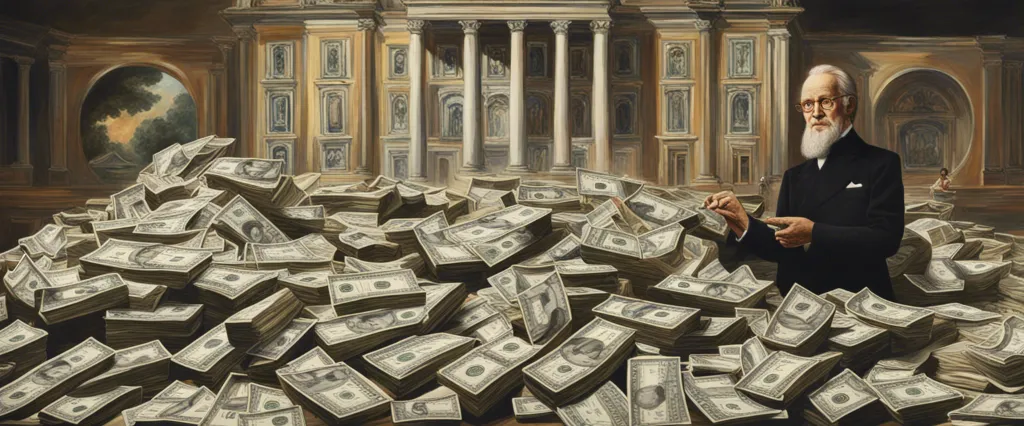
In “Money Changes Everything: How Finance Made Civilization Possible,” author William N. Goetzmann takes readers on a captivating journey through the history of finance and its pivotal role in shaping human civilization. Goetzmann, a renowned scholar in finance and the winner of numerous awards for his research, including the Morgan Stanley-American Finance Association Award, brings his expertise to shed light on how the concept of money has transformed societies and economies over thousands of years. With intricate details and insightful analysis, the author unveils the profound influence of financial systems and instruments on everything from art and culture to politics and technology. Through his comprehensive examination, Goetzmann provides a fresh perspective on the intricate relationship between money and human progress.
Chapter 1: The Origins of Money
In Chapter 1 of “Money Changes Everything” by William N. Goetzmann, titled “The Origins of Money,” the author delves into the early history and development of money as a means of exchange. Goetzmann explores various theories and evidence to trace the origins of money back to ancient civilizations, challenging the common belief that money first arose as a result of economic necessity.
The chapter begins by examining the early systems of trade and barter, where goods and services were exchanged directly without the need for a common medium of exchange. However, Goetzmann argues that these systems were inefficient and limited, as they depended on coincidence of wants and lacked measure value.
The author then introduces the concept of “commodity money,” where certain items, such as shells, beads, and stones, started to be used as a recognized form of payment. These objects held intrinsic value due to their rarity or aesthetic appeal, allowing for easier transactions and greater flexibility in trade.
Goetzmann also explores the emergence of early coinage in various civilizations, such as China, India, and ancient Mesopotamia. Coins standardized in size and purity, stamped with the authority of the issuing government, created a universally accepted medium of exchange that facilitated trade and promoted economic growth.
As the chapter progresses, Goetzmann delves into the evolution of money from precious metals like gold and silver to paper money and the modern digital forms of currency. He emphasizes the crucial role of trust in maintaining the value and effectiveness of money, as societies progressed from using physical objects to relying on faith in centralized institutions.
Overall, Chapter 1 of “Money Changes Everything” provides a comprehensive overview of the historical origins of money, highlighting the importance of a standardized form of exchange in facilitating trade, economic development, and the rise of civilizations.
Chapter 2: The Power of Currency
In Chapter 2 of Money Changes Everything by William N. Goetzmann, titled “The Power of Currency,” the author explores the evolution and impact of different forms of currency throughout history. He emphasizes the fundamental role of money in shaping human societies, enabling trade, and fostering economic development.
Goetzmann delves into the origins of money, tracing it back to primitive forms of exchange, such as bartering and the use of shells, beads, and other commodities as a medium of trade. He emphasizes how money emerged as a means to overcome the limitations of the barter system, facilitating more efficient transactions and encouraging economic growth.
The author then discusses how the advent of standardized coins and paper money revolutionized trade and commerce. Ancient civilizations such as the Greeks, Romans, and Chinese contributed to the development of coins, which allowed people to easily measure and store value. This new medium of currency fostered economic expansion, as it facilitated long-distance trade and increased market liquidity.
Goetzmann further explores the impact of paper money, which originated in China and later spread to Europe. Paper money played a crucial role in stimulating economic growth during the Renaissance and Enlightenment periods. It allowed for increased borrowing and investment opportunities, encouraging commerce and the development of markets.
The chapter also highlights the crucial role played by governments in controlling and stabilizing currencies. Goetzmann explains how governments monopolized the production of currency to maintain economic stability and trust in the monetary system.
Overall, Chapter 2 of Money Changes Everything delves into the history and significance of different forms of currency, showcasing how the evolution of money has shaped human societies and facilitated economic progress.
Chapter 3: Money and Trade
Chapter 3: Money and Trade of the book Money Changes Everything by William N. Goetzmann explores the role of money in facilitating exchange and trade throughout history. The chapter presents a comprehensive overview of the evolution of money from primitive bartering systems to the complex financial systems of today.
The author begins by discussing the inherent limitations of bartering, where individuals would trade goods and services directly with each other. Although this system was effective in small, tightly-knit communities, it faced significant challenges when engaging in wider trade. Goods and services would often be unequal in value, making exchanges difficult to negotiate. This led to the development of a common medium of exchange – money.
The concept of money originated with the emergence of commodity money. Items such as shells, beads, or livestock were used as a medium for trade because they possessed intrinsic value and were mutually agreed upon as acceptable currency. Goetzmann delves into the significance of these early forms of money and how they facilitated trade, fostering economic growth.
The chapter moves on to explore the transition from commodity money to representative money, where paper notes or metal coins represented a specific value held in reserve. This shift allowed for greater flexibility in trade and enabled economies to flourish. Goetzmann examines the development of standardized coins and the establishment of early banking systems that further facilitated trade across regions and nations.
The final part of the chapter reflects on the role of money in the modern world. Goetzmann highlights how the creation of paper money and the rise of digital transactions have revolutionized the way we exchange goods and services. Furthermore, he emphasizes the importance of trust and government regulation in maintaining the stability and confidence in modern monetary systems.
In summary, Chapter 3: Money and Trade provides a detailed exploration of the historical evolution of money as a medium of exchange, from the primitive bartering systems to the sophisticated financial systems of today. It emphasizes the significance of money in driving economic growth and facilitating trade across different societies.
Chapter 4: The Evolution of Financial Systems

Chapter 4: The Evolution of Financial Systems from the book Money Changes Everything by William N. Goetzmann discusses the historical development and evolution of financial systems throughout different civilizations. The chapter explores how money and financial institutions have shaped societies, economies, and individuals.
Goetzmann begins by examining the ancient Mesopotamian civilization, where the concept of money evolved from a barter system to the use of clay tablets as a medium of exchange. He explains how the development of writing allowed for the establishment of legal and financial systems, facilitating the growth of trade and commerce.
The author then delves into the rise of ancient Egypt, focusing on the importance of accounting techniques and the use of credit, which enabled the construction of massive pyramids and temples. He highlights the Nile River’s role as an early financial center and emphasizes how financial innovations, such as coinage, contributed to the flourishing economies of ancient Greece and Rome.
Goetzmann further explores the economic systems of medieval Europe, discussing the emergence of centralized banking institutions, the development of paper money, and the evolution of lending practices. He emphasizes the impact of financial innovations like double-entry bookkeeping, which played a significant role in shaping modern accounting practices.
The author concludes the chapter by exploring the financial developments in the Islamic civilization, particularly the establishment of Islamic banking and finance principles. He highlights the importance of risk-sharing and profit-sharing arrangements, which differ from conventional interest-based systems.
Overall, Chapter 4 provides a comprehensive overview of the evolution of financial systems, tracing their origins from ancient civilizations to the medieval period. It demonstrates the pivotal role of financial innovations and institutions in promoting economic growth and societal development throughout history.
Chapter 5: Money and Empires
Chapter 5 of “Money Changes Everything” by William N. Goetzmann focuses on the relationship between money and empires throughout history. The chapter delves into how various empires have utilized money as a means of consolidating power, maintaining control, and shaping their societies.
The chapter begins by exploring the role of money in the rise and fall of ancient empires. It highlights how the Persians, under the rule of Cyrus the Great, established a standardized coinage system that facilitated trade and secured their empire. The Achaemenid Empire’s adoption of this monetary system allowed them to maintain control over a vast territory and establish economic links with other regions.
Furthermore, the chapter examines the Roman Empire’s monetary system and its influence on its vast imperial network. The Romans pioneered the use of paper money and implemented a sophisticated taxation system, which allowed them to finance their military conquests and maintain a stable economy. Additionally, the author discusses how the Roman emperors used coins to disseminate propaganda and assert their authority.
Goetzmann also explores the role of monetization in the Islamic world, particularly during the Abbasid Caliphate. The advent of paper money, known as the “flying money,” allowed the Caliphate to establish a robust financial system, stimulate trade, and create an economic powerbase.
The chapter concludes by highlighting the importance of financial innovations in European empires during the Age of Discovery. The author discusses the significance of currencies, such as the Spanish silver dollar and the British pound, in financing exploration and colonization efforts. These empires utilized money as a tool to control vast territories, exploit resources, and assert dominance over other societies.
Overall, Chapter 5 of “Money Changes Everything” showcases the pivotal role money has played in the rise and decline of empires throughout history. It demonstrates that the adoption of standardized currency systems, financial innovations, and effective monetary policies have been instrumental in shaping the trajectories of various empires.
Chapter 6: The Psychology of Money
Chapter 6 of William N. Goetzmann’s book “Money Changes Everything” explores the psychological aspects of money and how it influences our behavior and decision-making. The author emphasizes that understanding our own psychology is crucial for managing money successfully.
The chapter begins by examining how our upbringing and cultural background shape our beliefs and attitudes towards money. For instance, individuals growing up in families that emphasize frugality may be more cautious and risk-averse with their finances. Goetzmann also explores the psychological concept of “money scripts” – these are the implicit beliefs and assumptions we have about money, often inherited from our parents or developed through our own experiences.
The author highlights the influence of emotions on financial decision-making. He explains that financial decisions are often driven by fear or greed, leading to irrational behaviors. Goetzmann provides examples of how people tend to make impulsive investment decisions during market booms due to greed, only to sell everything in a panic during downturns fueled by fear.
Furthermore, the chapter delves into the concept of financial self-control and the importance of developing good saving and spending habits. Goetzmann emphasizes the impact of delayed gratification and how individuals who can resist immediate rewards often enjoy better long-term financial outcomes.
Ultimately, Goetzmann argues that understanding our own psychology is key to making sound financial decisions. By recognizing our biases, debunking money scripts, and managing emotions, we can develop a healthier relationship with money and achieve long-term financial stability and well-being.
Chapter 7: Financial Innovations and Disruptions
Chapter 7 of “Money Changes Everything” by William N. Goetzmann explores the fascinating world of financial innovations and disruptions throughout history. The chapter starts by emphasizing the importance of financial innovation in promoting economic growth and development.
Goetzmann first delves into the concept of securitization, which involves aggregating numerous individual loans or assets into a single financial instrument. He highlights the historical examples of securitization, such as the British South Sea Company in the 18th century, which allowed investors to purchase shares backed by government debt. This innovation enabled governments to raise large sums of money and introduced the first stock market bubble.
Another significant financial innovation discussed is the mutual fund. Goetzmann explains how mutual funds allow individual investors to pool their money and invest in a diversified portfolio managed by professionals. He delves into the history of mutual funds, emphasizing the role of Massachusetts Investors Trust in establishing this revolutionary investment vehicle in the early 20th century.
The chapter also explores the disruption caused by the introduction of electronic trading and the rise of online brokerage firms. Goetzmann explains how these technological advancements transformed stock market trading, making it faster, more efficient, and accessible to a wider range of individuals. He further discusses how algorithmic trading and high-frequency trading have further shaped the financial markets.
Additionally, Goetzmann examines the advent of new financial products and derivatives, such as credit default swaps (CDS), mortgage-backed securities (MBS), and collateralized debt obligations (CDO). He provides insights into how these complex financial instruments contributed to the 2008 global financial crisis.
Overall, Chapter 7 showcases the pivotal role of financial innovations and disruptions in shaping the world of finance. It highlights how these innovations have catalyzed economic growth, facilitated investment opportunities, and at times led to significant disruptions and crises.

Chapter 8: Money and Society’s Transformations
Chapter 8 of the book “Money Changes Everything” by William N. Goetzmann explores the profound impact of money on society throughout history. This chapter primarily focuses on the transformations brought about by monetary systems and the ways in which they have shaped our social structures and interactions.
One key aspect discussed in this chapter is the transition from barter economies to money-based systems. Goetzmann explains how money has emerged as a medium of exchange, allowing individuals to acquire desired goods or services, regardless of the coincidence of wants that hinders barter arrangements. This transformative power of money has facilitated the expansion of trade, specialization, and the growth of civilizations.
Furthermore, the author examines the role of banking and credit systems in shaping societies. He highlights that the development of money allowed for the creation of banking institutions, enabling loans and investments that stimulate economic growth. However, Goetzmann also emphasizes the potential risks associated with banking, such as financial crises and economic instability.
In addition to exploring the economic implications, Goetzmann delves into the social consequences of money. He discusses how money can be used as a tool for social control or liberation, depending on its distribution and accessibility. The author examines historical instances where money has been withheld from certain groups, perpetuating social inequalities, but also acknowledges that money can empower marginalized communities if redistributed more equitably.
Overall, Chapter 8 of “Money Changes Everything” highlights the far-reaching influence of money in shaping societies. It discusses the shift from barter economies to monetary systems, the role of banking and credit, and the social implications of money distribution. By illuminating these transformations, Goetzmann offers insights into the complex relationship between money and society throughout history.
After Reading
In conclusion, “Money Changes Everything” by William N. Goetzmann provides a comprehensive exploration of the historical significance and transformative power of money. Through a detailed examination of different civilizations and financial systems, Goetzmann reveals the profound influence money has had on society, art, and culture. From ancient forms of currency to modern financial innovations, the author highlights the pivotal role money plays in facilitating trade, fueling economic growth, and shaping human behavior. Furthermore, Goetzmann argues that our evolving understanding and utilization of money have driven societal progress and ultimately transformed our world. With thought-provoking insights and compelling examples, “Money Changes Everything” encourages readers to critically reflect on the complex relationship between money and humanity, leaving them with a deeper appreciation for its role in shaping our lives.
1. “Life in a Medieval City” by Frances Gies: This fascinating book offers an immersive journey into the daily lives of ordinary people in a medieval city. Frances Gies’s meticulous research takes readers back to the bustling streets, lively markets, and social customs of the Middle Ages. With engaging storytelling and rich historical details, this book is a must-read for history enthusiasts and those interested in understanding the complexities of medieval urban life.
2. “Islam Between East and West” by Alija Izetbegović: Alija Izetbegović, the first President of Bosnia and Herzegovina, presents a profound exploration of Islam’s position between two contrasting civilizations—Eastern and Western. Delving into the historical context, cultural influences, and the challenges faced by Muslims, Izetbegović offers a unique perspective on Islam’s role in contemporary society. This thought-provoking book encourages readers to consider Islam’s intersection with the modern world and fosters a deeper understanding of the religion and its diverse manifestations.
3. “BITCHfest” by Margaret Cho: Margaret Cho, a renowned comedian and activist, curates a collection of essays that celebrate and challenge modern feminism. “BITCHfest” brings together a diverse group of voices, engaging in lively conversations about gender, race, sexuality, and other pertinent social issues. This anthology offers a refreshing and unapologetic exploration of feminism’s evolving landscape, making it a compelling read for anyone passionate about equality and intersectional feminism.
4. Madame Bovary” by Gustave Flaubert: Often hailed as a masterpiece of literary realism, “Madame Bovary” is a captivating novel that delves into the life of Emma Bovary, a disillusioned provincial woman trapped in a loveless marriage. Through Gustave Flaubert’s exquisite prose, readers are transported into Emma’s world, witnessing her desires, fantasies, and the consequences of her pursuit of passion. This timeless classic raises profound questions about the human condition and the consequences of romantic escapism.
5. Sapiens: A Brief History of Humankind” by Yuval Noah Harari: In this thought-provoking book, Yuval Noah Harari takes readers on a sweeping journey through the history of Homo sapiens, exploring our origins, societal development, and the impact we have had on the planet. Harari blends anthropology, biology, and history to offer a compelling narrative that challenges conventional wisdom and prompts us to reconsider our place in the world. “Sapiens” is a captivating and accessible read that offers a fresh perspective on the human story.




Comments
This information is magnificent. I understand and respect your clear-cut points. I am impressed with your writing style and how well you express your thoughts.